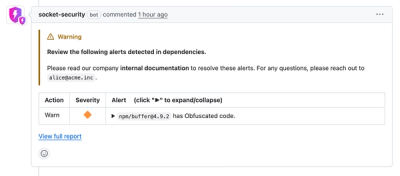
Security News
Crates.io Users Targeted by Phishing Emails
The Rust Security Response WG is warning of phishing emails from rustfoundation.dev targeting crates.io users.
redux-to-vuex
Advanced tools
像书写vuex一样书写redux!
npm install redux-to-vuex
如果你使用过dva那么redux-to-vuex跟他很像,但是redux-to-vuex只是改造actions、reducers,并没有重写,因此在一些只使用原生redux的项目中(多数为小程序)或者无法忍受redux复杂的书写,可以尝试使用redux-to-vuex。
models/model
export default {
// 命名空间
namespace: 'counter',
// 初始化state
state: {
count: 0,
},
// reducers 同步更新 类似于vuex的mutations
reducers: {
add(state, action) {
return {
...state,
count: state.count + 1
}
},
},
// reducers 异步更新 类似于vuex的actions
effects: {
someEffect(action, { dispatch }) {
setTimeout(() => {
dispatch({
type: "counter/add"
})
}, 2000)
return
}
}
}
models/index
import reduxToVuex from 'redux-to-vuex'
import { createStore, applyMiddleware, combineReducers } from 'redux'
import { createLogger } from 'redux-logger'
//model
import counter from './counter'
const reduxTree = reduxToVuex({
counter
})
const middlewares = [
reduxTree.effectMiddler,
createLogger()
]
const store = createStore(combineReducers(reduxTree.reducers), applyMiddleware(...middlewares))
export default store
你的mian.js就想引入普通的store一样
import React from 'react';
import ReactDOM from 'react-dom';
import './index.css';
import App from './App';
import { Provider } from 'react-redux'
import store from "./models"
ReactDOM.render(<Provider store={store}>
<App />
</Provider>, document.getElementById('root'));
在使用它的组件中如同使用redux一样
import React, { Component } from 'react';
import { connect } from 'react-redux'
import './App.css';
class App extends Component {
add = () => {
const { dispatch } = this.props;
dispatch({
type: "counter/add",
payload: "参数"
})
}
dec = () => {
const { dispatch } = this.props;
dispatch({
type: "counter/minus",
payload: "参数"
})
}
asyncAdd = () => {
const { dispatch } = this.props;
dispatch({
type: "counter/someEffect",
payload: "参数"
})
}
render() {
return (
<div className="App">
<div className='todo'>
<button className='add_btn' onClick={this.add}>+</button>
<button className='dec_btn' onClick={this.dec}>-</button>
<button className='dec_btn' onClick={this.asyncAdd}>async</button>
<div>{this.props.count}</div>
</div>
</div>
);
}
}
const mapStateToProps = ({ counter }) => {
const { count } = counter;
return {
count
}
}
export default connect(mapStateToProps)(App);
这里有个例子可以让你更清楚如何使用redux-to-vuex
MIT
FAQs
像vuex一样书写redux
We found that redux-to-vuex demonstrated a not healthy version release cadence and project activity because the last version was released a year ago. It has 1 open source maintainer collaborating on the project.
Did you know?

Socket for GitHub automatically highlights issues in each pull request and monitors the health of all your open source dependencies. Discover the contents of your packages and block harmful activity before you install or update your dependencies.

Security News
The Rust Security Response WG is warning of phishing emails from rustfoundation.dev targeting crates.io users.

Product
Socket now lets you customize pull request alert headers, helping security teams share clear guidance right in PRs to speed reviews and reduce back-and-forth.

Product
Socket's Rust support is moving to Beta: all users can scan Cargo projects and generate SBOMs, including Cargo.toml-only crates, with Rust-aware supply chain checks.